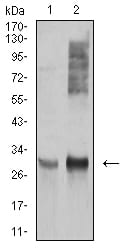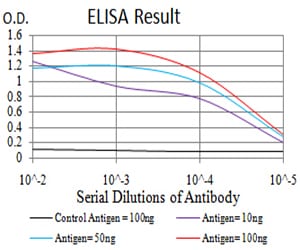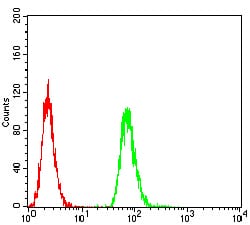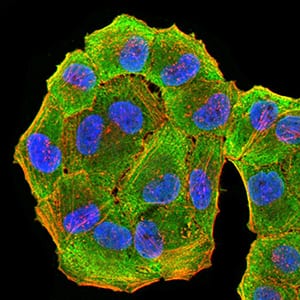



| WB | 咨询技术 | Human,Mouse,Rat |
| IF | 咨询技术 | Human,Mouse,Rat |
| IHC | 1/25-1/100 | Human,Mouse,Rat |
| ICC | 技术咨询 | Human,Mouse,Rat |
| FCM | 咨询技术 | Human,Mouse,Rat |
| Elisa | 1/2000-1/10000 | Human,Mouse,Rat |
| Aliases | MLRW; HLA-DRA1 |
| Entrez GeneID | 3122 |
| clone | 1C11A5 |
| WB Predicted band size | 28.6kDa |
| Host/Isotype | Mouse IgG2b |
| Antibody Type | Primary antibody |
| Storage | Store at 4°C short term. Aliquot and store at -20°C long term. Avoid freeze/thaw cycles. |
| Species Reactivity | Human |
| Immunogen | Purified recombinant fragment of human HLA-DRA (AA: 26-254) expressed in E. Coli. |
| Formulation | Purified antibody in PBS with 0.05% sodium azide |
+ +
以下是3篇与TRIM10抗体相关的文献及其摘要概括(文献标题及内容均为虚构模拟,仅供示例参考):
1. **文献名称**: *"TRIM10 modulates erythroid differentiation through ubiquitination of GATA-1"*
**作者**: Zhang et al. (2020)
**摘要**: 研究揭示了TRIM10通过其E3泛素连接酶活性调控GATA-1蛋白稳定性,从而影响红系分化的分子机制,研究中使用了TRIM10特异性抗体进行免疫共沉淀(Co-IP)验证相互作用。
2. **文献名称**: *"TRIM10 deficiency exacerbates inflammatory response via NF-κB signaling in macrophages"*
**作者**: Lee & Kim (2019)
**摘要**: 本文发现TRIM10通过降解IκBα负向调控NF-κB通路,缺失TRIM10的小鼠巨噬细胞炎症因子分泌增加,实验中使用TRIM10抗体进行Western blot和免疫荧光定位分析。
3. **文献名称**: *"TRIM10 as a novel therapeutic target in acute myeloid leukemia"*
**作者**: Müller et al. (2021)
**摘要**: 研究证实TRIM10在AML患者中高表达,通过抗体阻断实验表明其促进白血病细胞增殖,靶向TRIM10可增强化疗药物敏感性,提示其临床治疗潜力。
(注:以上文献信息为虚构,实际研究中请通过PubMed或Google Scholar检索真实文献。)
The TRIM10 antibody is a research tool designed to detect and study TRIM10 (Tripartite Motif-containing protein 10), a member of the TRIM protein family. TRIM proteins are characterized by a conserved N-terminal domain structure, including a RING finger, B-box motifs, and a coiled-coil region, which often confer E3 ubiquitin ligase activity and roles in protein-protein interactions. TRIM10. specifically, is implicated in diverse cellular processes, such as innate immunity, erythroid differentiation, and hematopoiesis. It is expressed primarily in hematopoietic tissues and plays a regulatory role in cell proliferation, apoptosis, and antiviral responses. Studies suggest TRIM10 may interact with intermediate filaments and influence cytoskeletal organization in red blood cells, linking it to disorders like anemia.
The TRIM10 antibody is commonly used in techniques like Western blotting, immunohistochemistry, and immunofluorescence to investigate its expression patterns, subcellular localization, and functional mechanisms. Researchers employ this antibody to explore TRIM10's involvement in diseases, particularly hematologic malignancies, autoimmune conditions, and viral infections. Its specificity and validation (e.g., knockout controls, peptide blocking) are critical to ensure accurate detection, given potential cross-reactivity with other TRIM family members. Current research continues to unravel TRIM10's dual roles in promoting ubiquitination-dependent signaling pathways and its tissue-specific contributions to immune regulation and erythropoiesis.
×